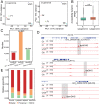Genome-wide chromatin accessibility analysis unveils open chromatin convergent evolution during polyploidization in cotton
- PMID: 36279429
- PMCID: PMC9636936
- DOI: 10.1073/pnas.2209743119
Genome-wide chromatin accessibility analysis unveils open chromatin convergent evolution during polyploidization in cotton
Abstract
Allopolyploidization, resulting in divergent genomes in the same cell, is believed to trigger a "genome shock", leading to broad genetic and epigenetic changes. However, little is understood about chromatin and gene-expression dynamics as underlying driving forces during allopolyploidization. Here, we examined the genome-wide DNase I-hypersensitive site (DHS) and its variations in domesticated allotetraploid cotton (Gossypium hirsutum and Gossypium barbadense, AADD) and its extant AA (Gossypium arboreum) and DD (Gossypium raimondii) progenitors. We observed distinct DHS distributions between G. arboreum and G. raimondii. In contrast, the DHSs of the two subgenomes of G. hirsutum and G. barbadense showed a convergent distribution. This convergent distribution of DHS was also present in the wild allotetraploids Gossypium darwinii and G. hirsutum var. yucatanense, but absent from a resynthesized hybrid of G. arboreum and G. raimondii, suggesting that it may be a common feature in polyploids, and not a consequence of domestication after polyploidization. We revealed that putative cis-regulatory elements (CREs) derived from polyploidization-related DHSs were dominated by several families, including Dof, ERF48, and BPC1. Strikingly, 56.6% of polyploidization-related DHSs were derived from transposable elements (TEs). Moreover, we observed positive correlations between DHS accessibility and the histone marks H3K4me3, H3K27me3, H3K36me3, H3K27ac, and H3K9ac, indicating that coordinated interplay among histone modifications, TEs, and CREs drives the DHS landscape dynamics under polyploidization. Collectively, these findings advance our understanding of the regulatory architecture in plants and underscore the complexity of regulome evolution during polyploidization.
Keywords: chromatin accessibility; cotton; genome evolution; histone modification; polyploidization.
Conflict of interest statement
The authors declare no competing interest.
Figures






References
-
- Van de Peer Y., Mizrachi E., Marchal K., The evolutionary significance of polyploidy. Nat. Rev. Genet. 18, 411–424 (2017). - PubMed
-
- Stebbins G. L. Jr., Types of polyploids; their classification and significance. Adv. Genet. 1, 403–429 (1947). - PubMed
-
- Madlung A., Wendel J. F., Genetic and epigenetic aspects of polyploid evolution in plants. Cytogenet. Genome Res. 140, 270–285 (2013). - PubMed
Publication types
MeSH terms
Substances
LinkOut - more resources
Full Text Sources

